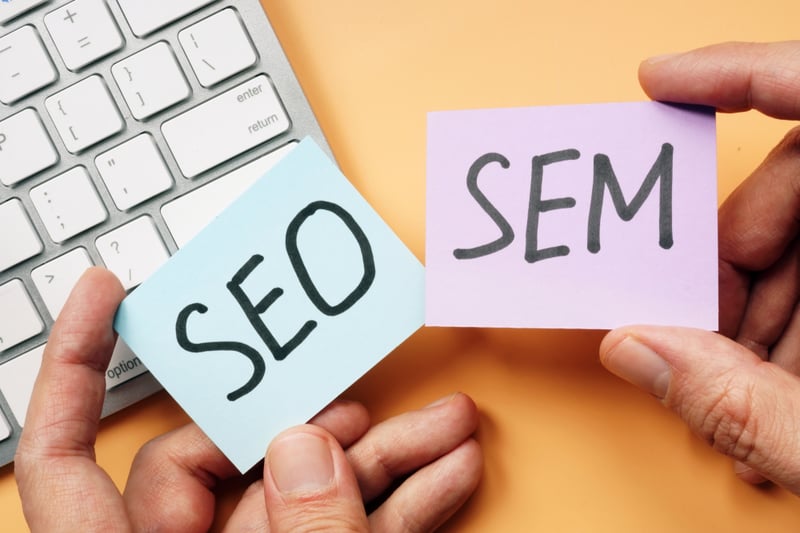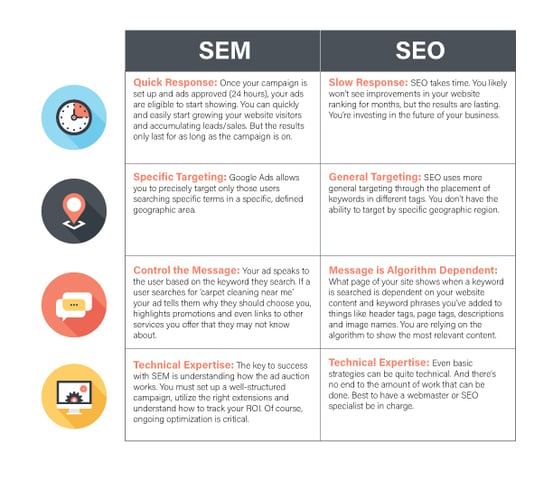
SEM, Paid Search, SEO, PPC and Google Ads. Which one of these is not like the other? Not a clue? Don’t worry, you’re not alone.
As more businesses rely on their websites to attract new customers, they are also eager to understand how to promote those sites. It can become overwhelming trying to make sense of the acronyms and phrases that float around when answering the question “How can I get my website to show higher on Google?”(Yes, there are other search engines. But when 90% of users turn to Google for their queries, there really aren’t.)
When it comes to increasing your visibility or ranking on Google, it really boils down to two categories: SEM and SEO. They both help you rank higher on Google so more people see your site and click on it. But SEM and SEO are not the same thing. Let’s dive into what they stand for and how they each work.
What is SEO?
Search Engine Optimization (SEO) is a technical strategy to boost your organic website ranking. Some people refer to organic ranking as your ‘free’ website listing. It is true, your organic website impressions and clicks are free. However, many companies invest in SEO (hire someone) because they don’t have the resources or expertise internally to do SEO effectively. So, not exactly free. SEO is tricky because there is always more you can do. And even the basic steps of optimization are quite technical like submitting proper sitemaps, setting up plug-ins to help with page keyword optimization, properly naming your images, adding header tags, meta tags and more! Obviously, you need to know what you’re doing or hire someone who does if you want to effectively optimize.
What is SEM?
Search Engine Marketing (SEM) is a strategy to boost your website ranking via paid ads. To get started, you must set up a campaign in Google Ads (to show on Google). You choose keywords you think your prospective customers will search, write ads related to those keywords and set bids. Your ads are then eligible to show on Google above or below the organic search results (the free ones we mentioned above). Where you show depends on multiple factors including your bid and how well your campaign is structured. It’s free for your ad to show (impression). But if someone clicks on your ad and goes to your website, you pay. That’s why it’s often referred to as Pay Per Click (PPC), Cost Per Click (CPC) and Paid Search. You’re paying to get a specific audience to click-through to your website.
Now that you have a clearer picture of what SEO and SEM are, the next natural question is which one do I need? Most successful businesses are investing in both. If that’s not an option, consider these key differences:

Clearly, there is a lot to consider. For example, if you’re a new business trying to get a jump start, then investing in an SEM campaign to get your name out there and get some sales under your belt might be a good idea - especially since a new website will take time to be indexed and ranked by Google.
The same goes for a client whose website rankings are low (second page or greater). An SEM campaign is a great way to ensure you’re not losing visibility with your prospective customers on search while you work to improve your organic website ranking.
On the flip side, if your website has a strong presence on Google already, then continuing to invest in SEO might be the right answer for you. Again, there’s always the opportunity to be doing more when it comes to SEO. It’s just a matter of additional technical and manual optimization.
The Bottom Line
SEO and SEM are both very powerful digital marketing tactics. Taking the time to understand how they each can benefit your business is the first critical step. So, congratulations on doing just that! If you’d like to learn more or are ready to start investing SEO or an SEM campaign, contact Zimmer Communications.
